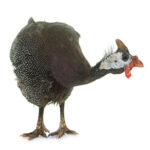Are tiny bugs buzzing around your fruit bowl or hovering near your kitchen sink? You might be dealing with fruit flies or gnats. These common household pests can be incredibly annoying, but thankfully, getting rid of them doesn’t require expensive solutions or harsh chemicals. You probably already have everything you need right in your kitchen to create effective traps and send these pests packing!
Like many homeowners, we recently faced a fruit fly invasion in our home. This unexpected encounter gave us the perfect opportunity to put various elimination methods to the test. After thorough experimentation and detailed notes, we’re excited to share the most effective DIY fruit fly and gnat traps you can easily make at home.
These homemade traps are not only simple to create but also utilize natural, readily available ingredients. They’re a fantastic D.I.Y., chemical-free approach to pest control. For those who prefer a humane solution, we’ll also discuss options that allow you to release the captured fruit flies and gnats outdoors. Beyond traps, we’ll also provide essential tips for preventing future infestations of these pesky insects.
Understanding Your Tiny Invaders: Fruit Flies and Gnats
Fruit flies are small, winged insects known for their attraction to ripe and fermenting fruits and vegetables – hence their name. They’re also drawn to sugary spills, alcoholic beverages, and even damp drains where organic matter accumulates. You’ll often find them congregating around fruit bowls, garbage disposals, trash cans, and areas with spilled juice or wine. Visually, they resemble tiny, pale brown or tan flies, about the size of a grain of rice, often with distinctive red eyes. Fruit flies are most prevalent during warmer months when fruits are abundant.
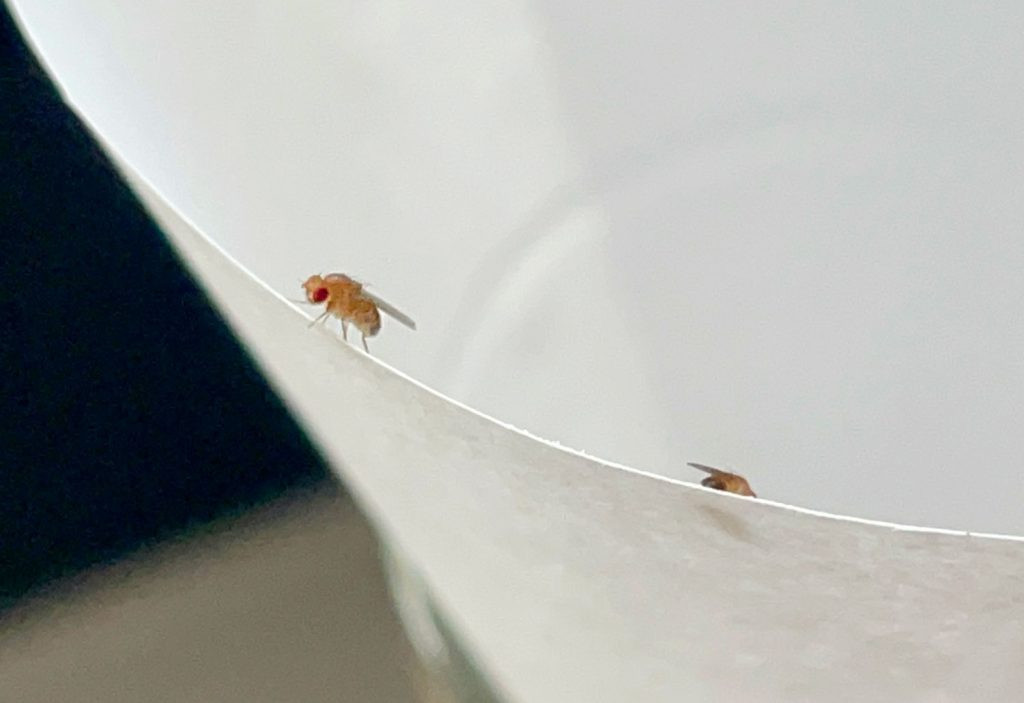 Close Up Of Fruit Fly On Paper Funnel
Close Up Of Fruit Fly On Paper Funnel
Alt text: Detailed close-up of a fruit fly with red eyes perched on the edge of a paper funnel trap, illustrating the insect’s small size and features.
A small fruit fly problem can quickly escalate. Just a few fruit flies brought into your home on fruits can lead to a full-blown infestation because females lay hundreds of eggs. These eggs can hatch in as little as 24 hours, and the new generation reaches adulthood in just days. Rapid reproduction is why swift action is crucial to eliminate fruit flies and prevent a swarm.
Identifying Fruit Flies vs. Fungus Gnats vs. Drain Flies
It’s easy to confuse fruit flies with other small flying insects commonly found indoors, particularly fungus gnats and drain flies. While all are small and annoying, correct identification is key to choosing the most effective removal method. The easiest way to distinguish them is by location and general appearance compared to larger insects:
- Fruit Flies: Resemble miniature houseflies. Found near overripe fruit, garbage, spills, and sugary or fermented substances.
- Drain Flies: Look like small, fuzzy moths. Typically seen around sinks, drains, and damp areas, often fluttering weakly.
- Fungus Gnats: Resemble tiny mosquitoes with longer legs. Usually found near houseplants and damp potting soil, where they breed.
If you’re uncertain which pest you’re dealing with, try one of the traps described below. If it attracts the insects in your home, you’re likely dealing with fruit flies or potentially gnats if placed near plants.
Simple and Effective DIY Fruit Fly and Gnat Traps
Getting rid of fruit flies and gnats doesn’t have to be a complicated or expensive process. With a few common household items and a bit of patience, you can significantly reduce their numbers. The principle behind each of these traps is the same: lure the fruit flies or gnats into a contained area and prevent their escape. We tested four popular DIY methods and found a clear winner. Since each trap uses items you likely already have, experimenting with a few different types is easy and worthwhile. Consider yourself a fruit fly and gnat scientist for a day!
Here are four effective DIY traps we tested:
- Paper Funnel Trap
- Plastic Wrap Trap
- Dish Soap Trap
- Rotting Fruit Trap
We’ll provide detailed instructions for each method and share our results below. Keep in mind that some traps work faster than others, and it may take a few days to fully resolve your fruit fly or gnat issue.
#1: The Classic Paper Funnel Fruit Fly and Gnat Trap
This trap uses a simple paper funnel to guide fruit flies and gnats into a container baited with an attractant. The narrow opening at the funnel’s bottom makes it easy for them to enter but difficult to exit.
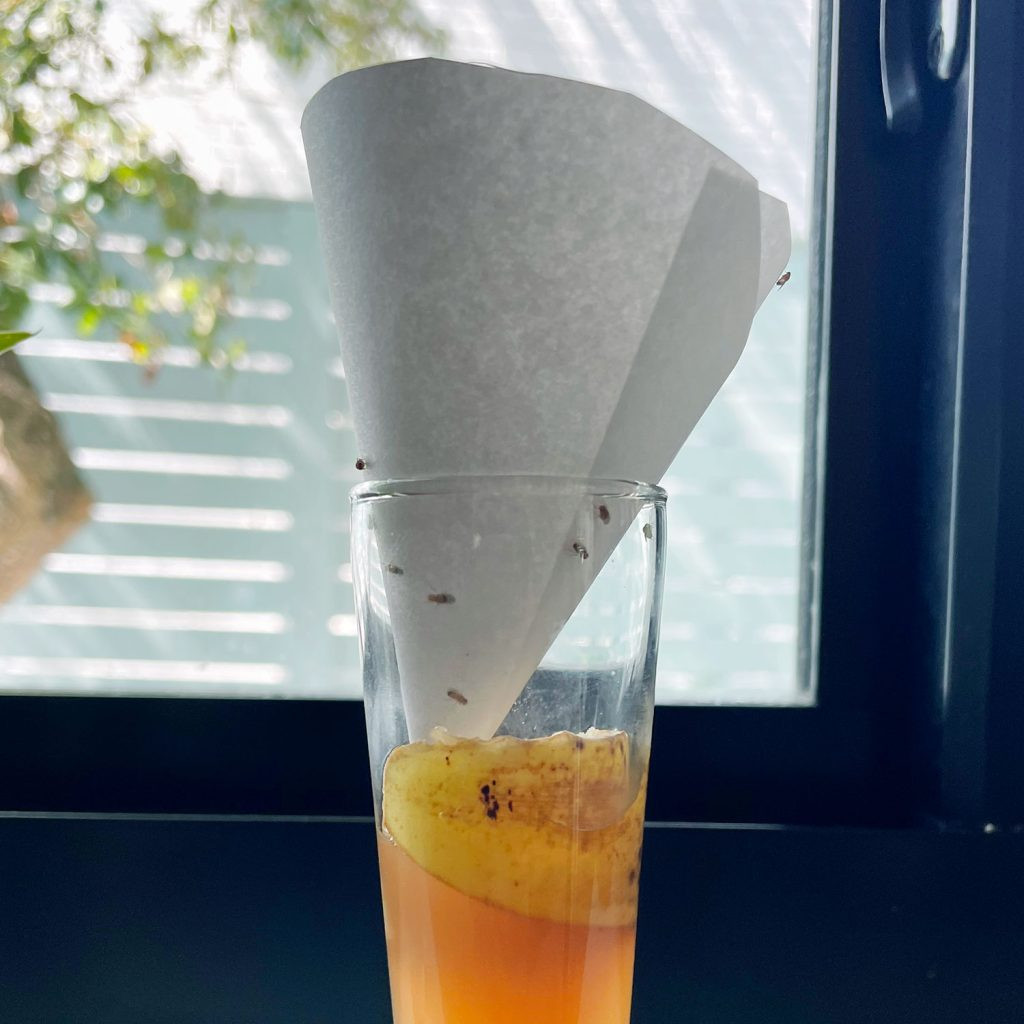 DIY Fruit Fly Trap With Paper Funnel
DIY Fruit Fly Trap With Paper Funnel
Alt text: Step-by-step visual guide to creating a DIY fruit fly and gnat trap using a paper funnel inserted into a jar with apple cider vinegar.
Supplies:
- Small, clear jar, cup, or container (narrow opening preferred)
- Sheet of paper or cardstock
- Tape
- Scissors
- Apple cider vinegar (ACV)
Instructions:
- Select Your Container: Choose a small, clear container like a mason jar, empty food jar, or plastic bottle. A narrow opening is beneficial for this trap design.
- Add the Lure: Pour a small amount of apple cider vinegar, old beer, or wine into the container. These liquids are highly attractive to fruit flies and gnats. Apple cider vinegar is particularly effective.
- Create the Paper Funnel: Roll a piece of paper or cardstock into a cone shape with a very small opening at the tip. Secure the cone shape with tape. You can trim the tip to create a small hole, roughly the size of a grain of rice.
- Assemble the Trap: Place the paper funnel into the container opening. Adjust the funnel so it sits securely on the rim of the container without touching the liquid bait. Ensure there are no gaps around the funnel’s edge where flies or gnats could escape.
- Humane Release (Optional): To release captured insects, carefully carry the trap outdoors, ensuring the funnel remains in place. Once outside, remove the funnel to allow the fruit flies and gnats to fly away.
While store-bought funnels can be used, their openings are often too large, increasing the chance of trapped pests escaping. A homemade paper funnel provides a more precisely sized entry point.
#2: Simple Plastic Wrap Fruit Fly and Gnat Trap
Similar to the funnel trap, the plastic wrap trap uses an attractant to lure fruit flies and gnats into a container, but employs a plastic wrap top with tiny holes to trap them. The pests are drawn in by the scent but struggle to find their way back out through the small holes.
Supplies:
- Small, clear jar, cup, or container
- Rubber band
- Plastic wrap or plastic bag
- Toothpick
- Apple cider vinegar (ACV)
Instructions:
- Choose Your Container: Select a small, clear jar, cup, or similar container. Clarity helps you monitor trap effectiveness, but any small container will work, even an old can.
- Add the Lure: Pour apple cider vinegar into the container. The strong, sweet-sour scent is irresistible to fruit flies and gnats. Old beer or wine can also be used as alternatives to apple cider vinegar. Regular white vinegar is less effective.
- Seal with Plastic Wrap: Stretch plastic wrap tightly over the container opening and secure it firmly with a rubber band. Saran wrap works well, or you can use a piece cut from a plastic bag.
- Create Entry Holes: Use a toothpick to carefully poke a few small holes in the plastic wrap top. The holes should be just large enough for a fruit fly or gnat to enter. A few small holes are more effective than many large ones.
- Humane Release (Optional): To release, carefully take the trap outdoors without removing the plastic wrap. Remove the wrap outside to allow the trapped insects to escape.
Alternatively, you can adapt this method using a jar lid. Puncture small holes in a metal jar lid using a hammer and nail, then screw the lid onto the jar after adding the bait.
#3: Easy Dish Soap Fruit Fly and Gnat Trap
This trap is the simplest of the DIY methods, requiring no cover. It relies on the principle of surface tension; dish soap reduces the surface tension of the liquid, causing fruit flies and gnats to sink and drown rather than being able to fly away. Note: This method is not designed for humane release.
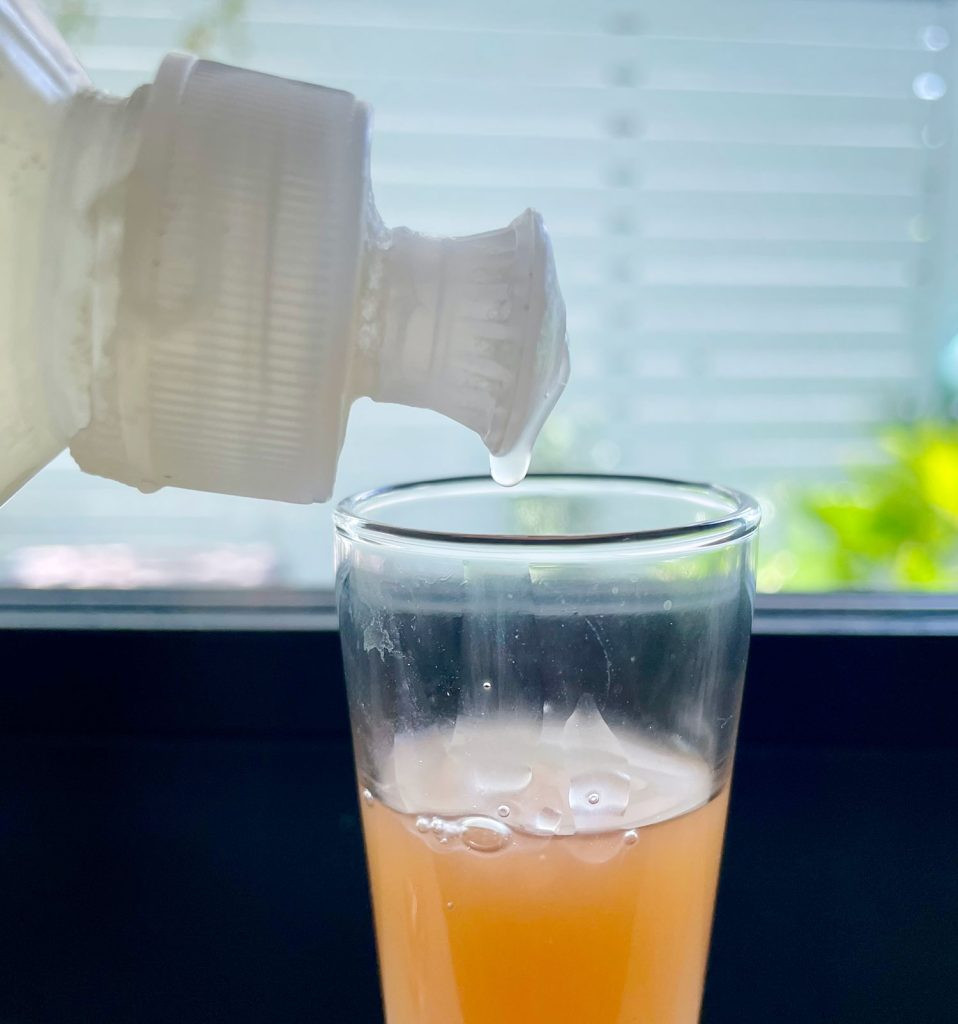 Dripping Dish Soap Into Apple Cider Vinegar For DIY Fruit Fly Trap
Dripping Dish Soap Into Apple Cider Vinegar For DIY Fruit Fly Trap
Alt text: Close-up shot of dish soap being squirted into a bowl of apple cider vinegar, demonstrating the preparation of a dish soap fruit fly and gnat trap.
Supplies:
- Small container, bowl, or dish
- Dish soap
- Apple cider vinegar (ACV)
Instructions:
- Pour in Apple Cider Vinegar: Pour apple cider vinegar into the bottom of a small container, bowl, or dish. The scent will attract the fruit flies and gnats.
- Add Dish Soap: Add a few drops of dish soap to the apple cider vinegar. Gently swirl to mix, creating a soapy solution. The soap breaks the surface tension, trapping the pests.
For enhanced effectiveness, you can combine the dish soap method with the plastic wrap or funnel traps. Simply add dish soap to the apple cider vinegar before covering the container with plastic wrap or a funnel. This offers multiple ways to trap and eliminate the pests.
#4: Using a Rotting Fruit Trap for Fruit Flies and Gnats
Fruit flies and gnats are naturally drawn to rotting fruit. This trap leverages that attraction by using fruit itself as the bait.
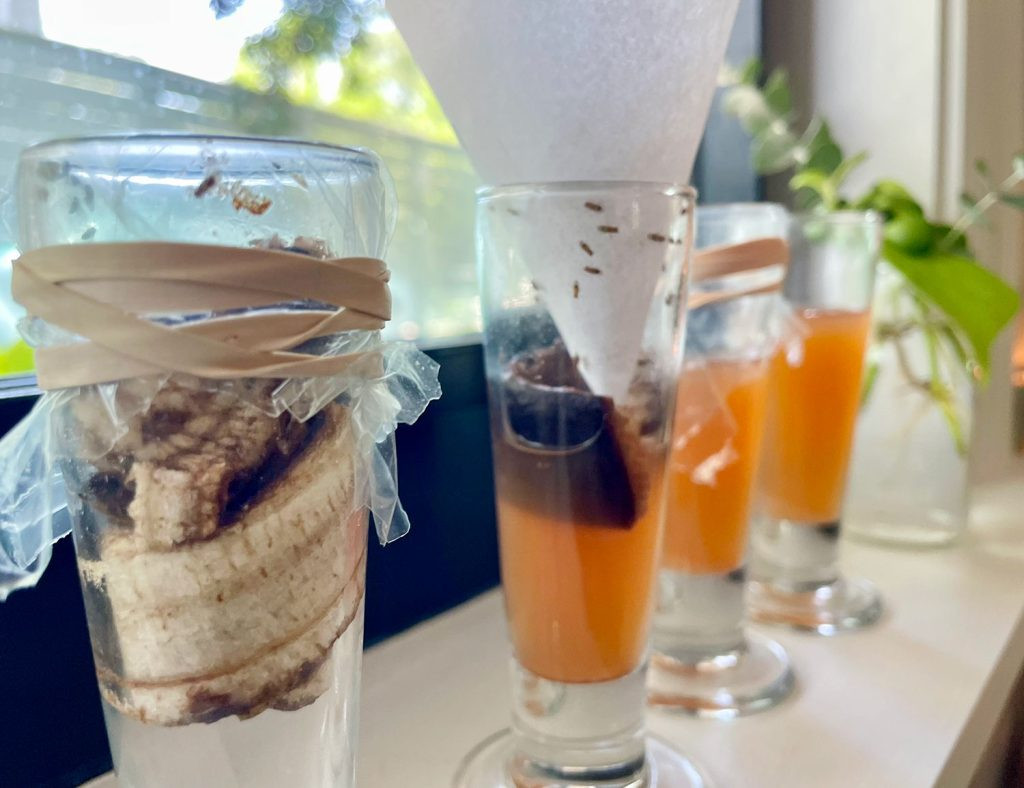 Close up side-by-side comparison of plastic wrap traps baited with banana peel, ACV and banana peel, ACV and soap, and dish soap and ACV.
Close up side-by-side comparison of plastic wrap traps baited with banana peel, ACV and banana peel, ACV and soap, and dish soap and ACV.
Alt text: Four DIY fruit fly and gnat traps lined up for comparison, showcasing different bait combinations: plastic wrap trap with banana peel, funnel trap with ACV and banana peel, plastic wrap trap with ACV and soap, and dish soap trap with ACV.
Supplies:
- Small jar, cup, or container
- Plastic wrap or paper funnel (depending on chosen trap style)
- Piece of ripe or overripe fruit (banana peel, apple slice, etc.)
Instructions:
To create a rotting fruit trap, simply replace the apple cider vinegar in either the Plastic Wrap Trap or Funnel Trap with a piece of ripe or overripe fruit like a banana peel, apple slice, peach slice, or strawberry. You can also enhance the fruit bait by adding a splash of apple cider vinegar. Be sure to replace the fruit every day or two to prevent unpleasant odors and maintain its attractiveness to pests.
Determining the Best Fruit Fly and Gnat Trap
In our experiments, we tested a combination of trap designs and baits to identify the most effective solution. The four homemade traps we compared were:
- Plastic Wrap Trap with banana peel
- Funnel Trap with ACV + banana peel
- Plastic Wrap Trap with ACV + dish soap
- Dish Soap Trap with ACV
Our results indicated that the type of bait was more critical than the trap design. Traps using banana peel as bait consistently outperformed those using only apple cider vinegar. In fact, the two plastic wrap traps were nearly identical in design, but the one baited with banana peel captured significantly more fruit flies and gnats than the ACV and soap trap. This suggests that while apple cider vinegar is effective, ripe fruit may be even more enticing, especially when real fruit sources are nearby.
Therefore, we recommend incorporating a piece of fruit into your trap, regardless of the design you choose. We slightly preferred the plastic wrap trap for its ease of construction and stability. The funnel trap, while effective, was more easily knocked over, potentially releasing captured pests back into the kitchen (oops!).
What Bait is Most Effective for Attracting Fruit Flies and Gnats?
Intrigued by the success of fruit scraps, we conducted a follow-up experiment to determine the most attractive fruit bait. We tested three readily available fruits: banana peel, apple slices, and a strawberry. Each fruit was placed in a separate Plastic Wrap Trap and positioned side-by-side on our counter for 24 hours.
While the banana peel initially appeared promising (being the ripest at the start), strawberries ultimately proved to be the most attractive bait. The strawberry trap captured the highest number of fruit flies and gnats. Banana peel also performed well, catching a significant number, but the strawberry’s appeal increased as it ripened further. Interestingly, apple slices attracted virtually no pests in our test.
Alt text: Side-by-side comparison of three plastic wrap fruit fly and gnat traps baited with banana peel, apple slices, and a strawberry, testing bait effectiveness.
Store-Bought Fruit Fly and Gnat Trap Options
If DIY traps aren’t working for you, or if you prefer a ready-made solution, several effective commercial fruit fly and gnat traps are available. These traps often have high customer ratings and are generally affordable (under $20). Store-bought traps might be a good option if you need to trap various types of flying insects or prefer a more discreet trap design.
 Collage of Storebought Fruit Fly Traps
Collage of Storebought Fruit Fly Traps
Alt text: Collage of various store-bought fruit fly and gnat traps available for purchase, showcasing different designs and brands.
During our testing, we purchased Terro Fruit Fly Traps to compare their performance against our homemade traps. We placed a Terro trap alongside our banana and strawberry traps for 24 hours to assess their relative effectiveness.
Initially, our homemade strawberry trap outperformed the store-bought trap, with the banana peel trap coming in second. The Terro trap caught only a single fruit fly in the first 24 hours. HOWEVER…
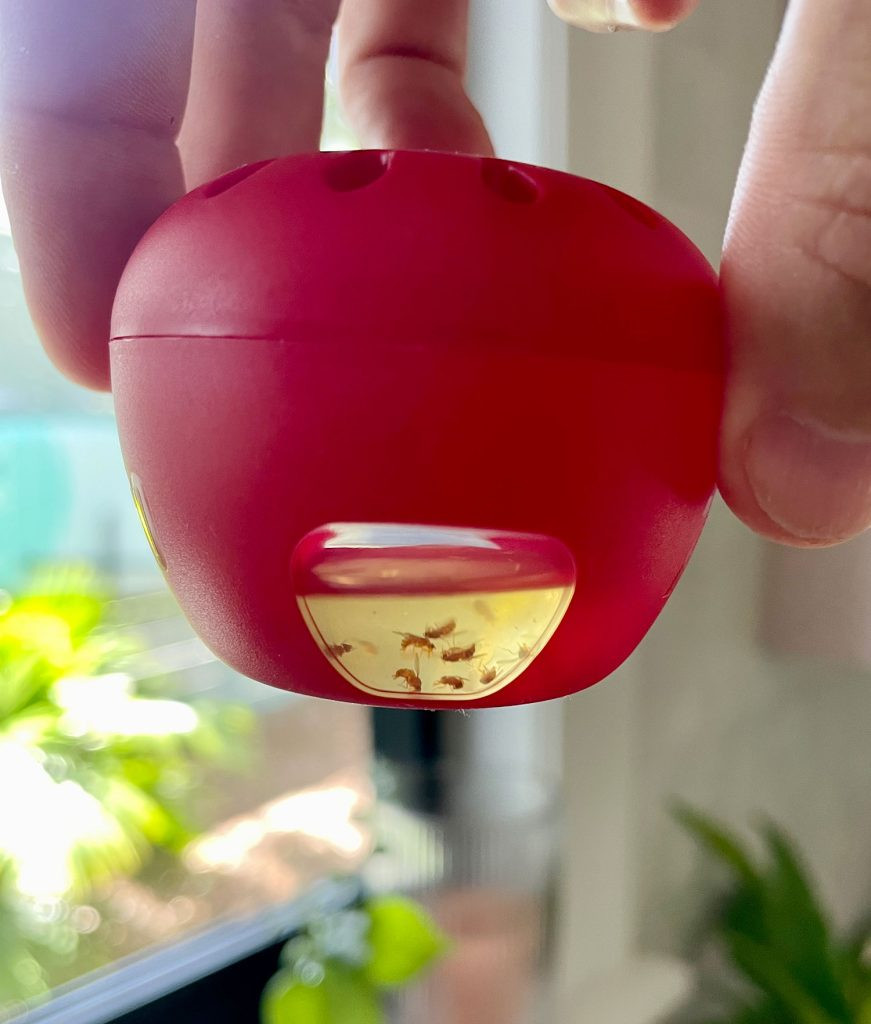 Terro Fruit Fly Trap With Dead Fruit Flies Visible
Terro Fruit Fly Trap With Dead Fruit Flies Visible
Alt text: Terro fruit fly and gnat trap filled with dead fruit flies and gnats, demonstrating its effectiveness over a longer period.
To ensure a fair comparison, we removed our DIY traps and left the Terro trap in place for another 24 hours. Over this extended period, the Terro trap effectively captured a significant number of fruit flies and gnats. While it didn’t work as quickly as our best homemade traps, it was still effective. Our conclusion: Store-bought traps are a good choice if you want a less conspicuous option, especially for long-term placement. However, for rapid results, homemade traps are often the quickest and most effective solution.
Preventing Fruit Flies and Gnats: Proactive Steps
While eliminating fruit flies and gnats is manageable, preventing infestations is always preferable. Here are simple preventative measures to keep these pests from becoming a problem in your home:
- Maintain Clean Kitchen Surfaces: Regularly wipe down kitchen counters, stovetops, tables, and all surfaces prone to collecting food residue or liquid spills. Fruit flies and gnats are particularly attracted to sugary substances, fruit juice, and alcohol, so promptly clean up any spills.
- Regularly Empty Trash: Food scraps left in your garbage can, especially overnight, can quickly become breeding grounds for fruit flies and gnats. Empty kitchen trash cans daily to eliminate potential food sources.
- Dispose of Overripe Fruit Promptly: Monitor your fruit bowl for overly ripe or decaying fruits like browning bananas or apples. Dispose of them before they attract pests and become breeding sites.
- Wash Produce Immediately After Purchase: Washing fruits and vegetables as soon as you bring them home from the grocery store can remove fruit fly and gnat eggs or larvae that may be present on the surface. (Note: Berries are best washed just before consumption to prevent premature spoilage).
- Refrigerate Produce When Possible: Fruit flies and gnats do not thrive in cold environments. Store fruits and vegetables in the refrigerator whenever feasible to deter infestations.
- Clean Sink Drains Regularly: Food particles and organic matter accumulating in sink drains can attract fruit flies and gnats. Use your garbage disposal regularly and flush drains with hot water and a drain cleaner periodically to eliminate these breeding sites.
Finally, if you spot fruit flies or gnats in your home, don’t panic! Quick action is important to prevent the problem from worsening. The DIY traps and preventative tips outlined in this article are easy to implement, effective, and fast-acting. You might even find yourself enjoying the process of becoming a fruit fly and gnat scientist, just like we did!
*This post contains affiliate links, so we may earn a small commission when you make a purchase through links on our site at no additional cost to you.
